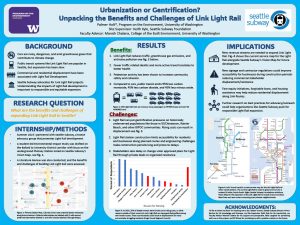URBANIZATION OR GENTRIFICATION? THE BENEFITS AND CHALLENGES OF EXPANDING LINK LIGHT RAIL IN SEATTLE
Despite its popularity and carbon mitigation potential, adoption of Link Light Rail in Seattle has been slow, expensive, and detested among some groups. Marginalized communities worry about gentrification, and commercial entities resist development- citing lengthy construction periods and accessibility issues. Seattle’s number one source of greenhouse gas emissions is automobiles. Automobiles are also noisy, dangerous, and can cause premature deaths from traffic accidents and pollution. This study was aimed at better understanding the socioecological benefits and challenges of connecting Seattle with reliable Light Rail Transit, while exploring strategies to mitigate those challenges. Over the summer I interned with Seattle Subway, a nonprofit transit advocacy group, to produce a draft Environmental Impact Study (EIS) on expanding Link Light Rail to Ballard, with emphasis on residential and commercial impacts. I accomplished this by referencing Sound Transit’s past EISs, attending weekly outreach events with Seattle Subway representatives, and conducting a literature review on Light Rail and sustainable development. Research shows that Light Rail, although capable of lowering emissions, noise, and traffic congestion, can also cause commercial and residential displacement, significant rises in housing costs, and lengthy construction periods making expansion unpopular among key stakeholders who often delay or cancel projects. Urgent legislative actions are needed to provide economic support to underserved communities in the path of Link Light Rail. Adding new construction regulations to protect local businesses and maintain accessibility could reduce business turnover. These actions, alongside advocacy, could help Seattle responsibly expand the Link Light Rail, lowering emissions and increasing mobility equity.
